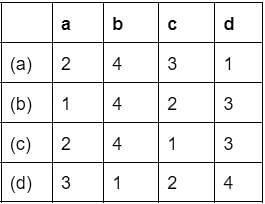Class 4 Exam > Class 4 Tests > Olympiad Test Level 2: Earth and Universe- 2 - Class 4 MCQ
Olympiad Test Level 2: Earth and Universe- 2 - Class 4 MCQ
Test Description
10 Questions MCQ Test - Olympiad Test Level 2: Earth and Universe- 2
Olympiad Test Level 2: Earth and Universe- 2 for Class 4 2024 is part of Class 4 preparation. The Olympiad Test Level 2: Earth and Universe- 2 questions and answers have been prepared
according to the Class 4 exam syllabus.The Olympiad Test Level 2: Earth and Universe- 2 MCQs are made for Class 4 2024 Exam.
Find important definitions, questions, notes, meanings, examples, exercises, MCQs and online tests for Olympiad Test Level 2: Earth and Universe- 2 below.
Solutions of Olympiad Test Level 2: Earth and Universe- 2 questions in English are available as part of our course for Class 4 & Olympiad Test Level 2: Earth and Universe- 2 solutions in
Hindi for Class 4 course.
Download more important topics, notes, lectures and mock test series for Class 4 Exam by signing up for free. Attempt Olympiad Test Level 2: Earth and Universe- 2 | 10 questions in 20 minutes | Mock test for Class 4 preparation | Free important questions MCQ to study for Class 4 Exam | Download free PDF with solutions
Detailed Solution for Olympiad Test Level 2: Earth and Universe- 2 - Question 1
Olympiad Test Level 2: Earth and Universe- 2 - Question 2
To weigh roughly two-thirds less than that you weigh on Earth, which planet would you be on?
Detailed Solution for Olympiad Test Level 2: Earth and Universe- 2 - Question 2
| 1 Crore+ students have signed up on EduRev. Have you? Download the App |
Olympiad Test Level 2: Earth and Universe- 2 - Question 3
GPS that tracks the location is an abbreviation of
Detailed Solution for Olympiad Test Level 2: Earth and Universe- 2 - Question 3
Detailed Solution for Olympiad Test Level 2: Earth and Universe- 2 - Question 4
Detailed Solution for Olympiad Test Level 2: Earth and Universe- 2 - Question 5
Olympiad Test Level 2: Earth and Universe- 2 - Question 6
The time required by moonlight to reach the Earth is
Detailed Solution for Olympiad Test Level 2: Earth and Universe- 2 - Question 6
Olympiad Test Level 2: Earth and Universe- 2 - Question 7
Which of the following planets is the largest in the inner planets?
Detailed Solution for Olympiad Test Level 2: Earth and Universe- 2 - Question 7
Olympiad Test Level 2: Earth and Universe- 2 - Question 8
The planet with maximum number of satellites is:
Detailed Solution for Olympiad Test Level 2: Earth and Universe- 2 - Question 8
Olympiad Test Level 2: Earth and Universe- 2 - Question 9
Which among the following doesn’t have its own light?
Detailed Solution for Olympiad Test Level 2: Earth and Universe- 2 - Question 9
Olympiad Test Level 2: Earth and Universe- 2 - Question 10
How many days does it take to complete one revolution around turn for planet Mercury?
Detailed Solution for Olympiad Test Level 2: Earth and Universe- 2 - Question 10
Information about Olympiad Test Level 2: Earth and Universe- 2 Page
In this test you can find the Exam questions for Olympiad Test Level 2: Earth and Universe- 2 solved & explained in the simplest way possible.
Besides giving Questions and answers for Olympiad Test Level 2: Earth and Universe- 2, EduRev gives you an ample number of Online tests for practice
Download as PDF




















